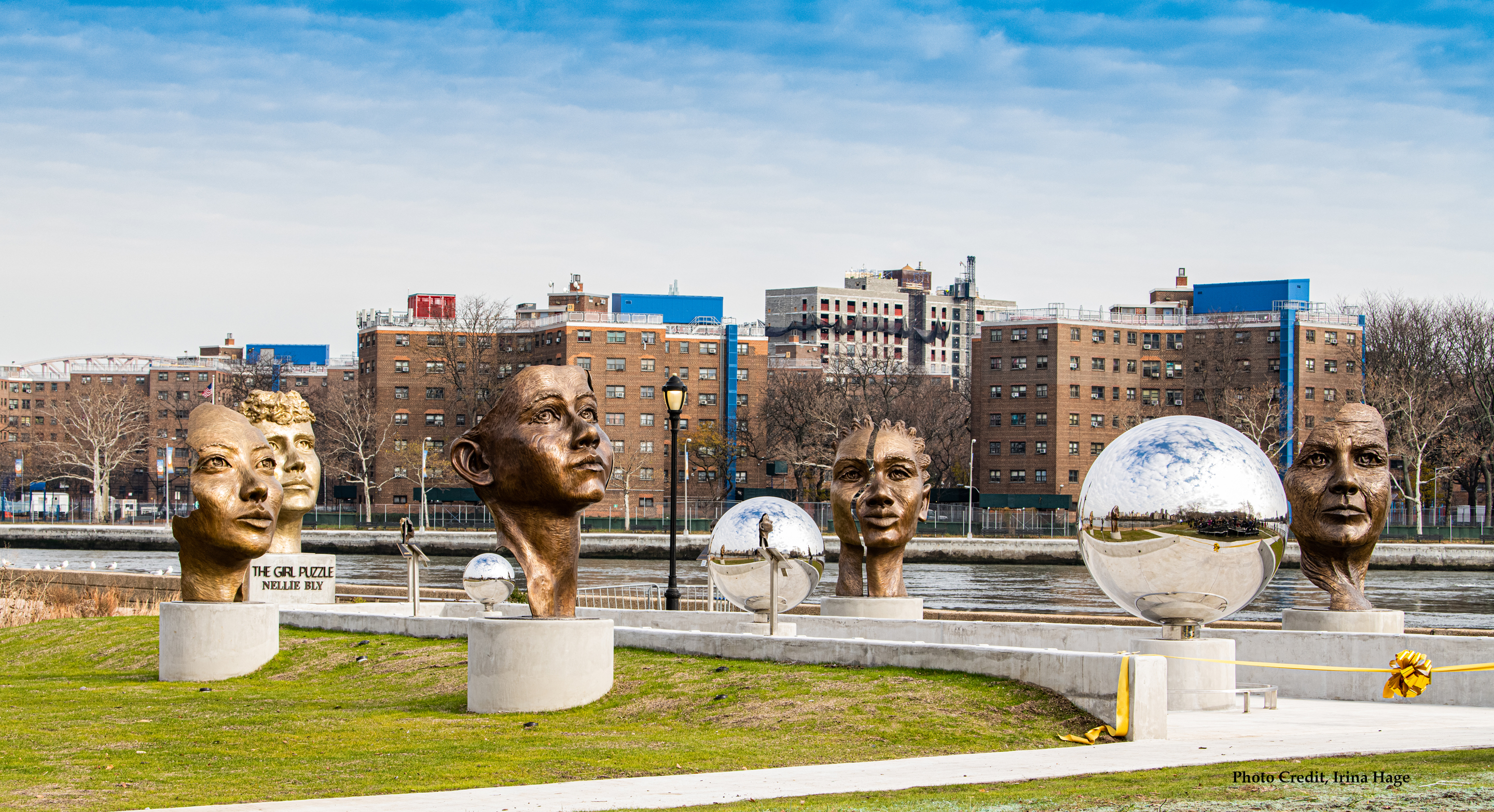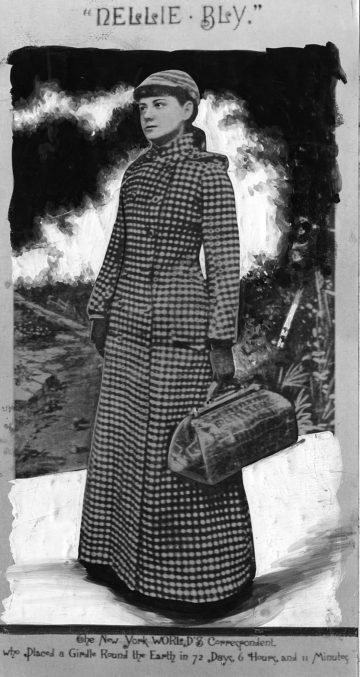Nellie Bly, Journalist and Changemaker, Is Honored With New York City Monument

She was a journalist, traveler, suffragist, inventor, industrialist, and woman’s rights activist, but first and foremost she was a humanitarian. Her name was Elizabeth Jane Cochran, but she was better known by her nom de plume, Nellie Bly.
Born in 1864 in Pennsylvania, she began her career at age 19 as a journalist at the Pittsburgh Dispatch when she wrote a rebuttal to a misogynist columnist who argued that girls were meant for having children and keeping house. His piece was called “What Are Girls Good For?” Bly responded with “The Girl Puzzle,” signed by “Lonely Orphan Girl.”
In 1887, having moved to New York City, where she was turned away by numerous newspaper editors, she found the offices of The New York World, owned by Joseph Pulitzer, and promptly talked her way into an undercover assignment that led to her feigning “madness” in order to investigate what was happening to women at the Women’s Lunatic Asylum on Blackwell Island, now Roosevelt Island. Her book, Ten Days in a Madhouse, which first appeared in The New York World as a series, resulted in changes in asylum care. The experience changed Nellie’s life and led to her becoming the first female investigative journalist in America.
A year later, Bly determined to take a world trip that would beat Phileas Fogg, the protagonist of Jules Verne’s Around the World in 80 Days, on a global trip. Her editor liked the idea, and 72 hours later, in a traveling suit and clutching a small “gripsack,” she was on her way, beating the fictional Fogg’s record by completing her trip in 72 days, having traveled solo for more than 21,700 miles. The trip made her famous worldwide.
But Nellie Bly’s biggest legacy remains her commitment to humanity, social change, and women’s lives. Motivated by the cruel treatment of women she had witnessed during her asylum experience, she found her true calling. “I have never had but one desire and that was to benefit humanity,” she said.
***
Until a few years ago, London-based writer Rosemary Brown had never heard of Nellie Bly, but once she discovered her, she knew she wanted to get the intrepid journalist “back on the map,” as she puts it. “We needed a genuine heroine to look up to in an era of synthetic celebrities, someone who defied convention, achieved the impossible, and championed society’s most vulnerable.”
A journalist, adventurer, and world traveler herself, Brown decided to follow Bly’s footsteps around the world and to write a book about it. The result was Following Nellie Bly: Her Record-Breaking Race Around the World, published in 2021.
Brown set off from London 125 years after Bly began her trip, traveling by air rather than boat and train as Bly had. She too wore a simple outfit and carried only a bag about the size of Bly’s. Thirty-two days later she returned to London, having traveled first to the home of Jules Verne in France where Bly and the great author had become friends. Brown continued to Sri Lanka, where she stayed in the Grand Oriental Hotel as Bly had, then visited the Hindu temple in Singapore where Bly was incensed at being denied entry because she was a woman. An intrepid traveler like Bly, Brown kept to her schedule despite racing to a train station during a typhoon in Hong Kong. In Japan, she stood where she was sure Bly had stood, “inside the belly of the Great Buddha of Kamakura.”
“The more I got to know her,” Brown says, “the more I was intrigued by this spirited woman who wouldn’t take no for an answer despite living in a world where women ‘knew their place.’ Nellie knew her place all right, smack dab on the front page of the world’s newspapers. She gave voice to the voiceless and challenged oppression wherever she found it.”
***
Rosemary Brown visited Nellie Bly’s grave in New York’s historic Woodlawn Cemetery before her return to London after her globetrotting journey. On December 10, 2021, she found herself in New York again, where she met sculptor Amanda Matthews, on the occasion of the dedication of a monument dedicated to Nellie Bly that Matthews created. The Girl Puzzle monument is located on Roosevelt Island near the asylum Bly exposed. The original Octagon section of the asylum where patients were admitted has been restored. The monument honors the life and legacy of Bly and is named for her reply to the man who thought women belonged at home. A modern-day response to discrimination and the invisibility of women, the moving monument was appropriately dedicated on International Human Rights Day.
Amanda Matthews, CEO and co-owner of Prometheus Art in Lexington, Kentucky, is an internationally recognized sculptor whose large-scale works, which often focus on women and nature, appear on state and federal government sites, in universities and corporations, and in private collections.
A degree in fine arts and philosophy, her study of art and architecture in France, and her own experiences with gender discrimination all inform and inspire her work. “I want to explore our individual and shared history, and to change the anemic scholarship of art, especially public art, which has traditionally focused on men of achievement, power, and dominance,” she says.
That focus was revealed in a 2021 study by the National Monument Audit undertaken by Monument Lab, a public arts project supported by the Andrew W. Mellon Foundation. It addresses the shocking inequality of women’s representation in public art, including the fact that fewer than 8% of statues in America commemorate women.

Matthews’ moving Girl Puzzle monument is dedicated to women whose histories are absent in public art. In addition to honoring Bly, Matthews created four other faces in the monument representing Asian, Black, young, old, immigrant, and queer women, all modeled on women Matthews knows.
Each of them, rendered in partial sections that appear like giant puzzle pieces, shows a depth of emotion and complexity that speaks to the reality of women’s lives. As viewers enter the monument walkway, they become part of the puzzle by interacting with the reflective surfaces and seeing sections of the faces come together at different vantage points.
Bly faces forward toward entering viewers. The others face toward Manhattan where Bly would have approached the island, with one exception: There is a face modeled on a Japanese American woman whose family suffered when President Franklin D. Roosevelt interned Japanese Americans during World War II; her face looks upon FDR’s monument, created after the war.
“Nellie Bly saw what was central to her society and knew that things needed to change. She understood that representation and humanity matters,” says Matthews. “I wanted to create public art that shows humanity in a space that is welcoming to everyone and that fosters connection and conversation while at the same time expressing my vision of what Nellie dedicated her life to.”
“I hope this monument conveys a better understanding of how Bly transcended the norm within her own historical context and how that directly relates to us today,” she says. “By advocating for others, Bly gave a voice and a face to women who had no visibility or prominence in society. She allowed women to inhabit new spaces and inspired change we still need to build upon. I hope this monument imparts to other women and girls a sense of belonging and a recognition that they too belong in in those spaces.”
***
Nellie Bly died in New York in 1922 at age 57. Rosemary Brown is currently researching the life of another intrepid traveling woman. Amanda Matthews is working on a COVID memorial that reveals the grit, determination, and innovation, as well as compassion, that people demonstrated during the epidemic. It will grace the grounds of the Kentucky state capital next year.
More articles by Category: Arts and culture
More articles by Tag: Art, History, Journalism, Women's history, Women's leadership



























